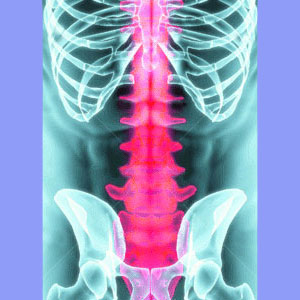
Osteoporosis sciatica may be linked to this sometimes devastating skeletal condition found mostly in elderly patients. Osteoporosis is a disorder involving low bone density and subsequent bone porosity. As we age, the body actually strips our bones of mineral content, which can make our skeletons weak and prone to injury.
Osteoporosis is a preventable condition in most instances, so it is crucial to maintain a healthy diet and exercise program while you are young, in order to prevent the potentially disabling condition from taking control of your body as you age.
This article will provide information on how the skeletal changes associated with osteoporosis can cause or contribute to sciatic nerve symptoms.
Osteoporosis Sciatica Issues
Osteoporosis is known as a painless disorder, even though it makes the bones soft and brittle. People generally do not know they even have the condition, since it does not generally elicit pain or neurological symptoms directly.
However, osteoporosis makes our bones prone to breaking easily and sometimes the mere weight of the body can cause bones to succumb. These compression fractures can occur in various places in the anatomy, but are most commonly experienced in the spinal vertebrae. Even with one or more collapsed vertebrae, many patients still do not feel any pain, unless the fracture came from a traumatic injury.
Regardless, these degenerated vertebrae can cause significant neurological issues if they collapse on spinal nerve roots or worse yet, the actual spinal cord itself. These are the circumstances which can create sciatica due to osteoporosis-enacted spinal changes.
Osteoporosis Prevention and Treatment
Osteoporosis is easily prevented in most people. It is crucial to maintain a diet rich in calcium and certain other nutrients, including magnesium and vitamin D. Skeletal loading exercise, like resistance training, is also a vital component of an osteoporosis prevention plan. These strategies must be used when a person is young, in order to better prevent the condition from occurring. Once osteoporosis begins, preventative medicine may be too little, too late.
Of course, there is a genetic component to the condition as well, but this does not mean that a given person will definitely develop porous bones. It does mean that people with particular genetic patterns are more disposed towards osteoporosis, particularly if preventative measures are not implemented.
Drugs, diet and exercise therapy are moderately effective in halting the progress on this condition and may even reverse it in some lucky patients. Obviously, the sooner low bone density is diagnosed, the better the treatment results will typically be. However, in patients with a genetic predisposition towards osteoporosis, reversal may be increasingly difficult once significant bone deterioration has begun.
Osteoporosis Sciatica Synopsis
Osteoporosis itself does not cause sciatica. However, once vertebrae collapse, a host of problematic syndromes may result, including back and leg pain. Women need to be particularly vigilant about preventing osteoporosis, since they are affected far more often and more severely than men.
It is lucky that the generally accepted beliefs about living a healthy lifestyle will also usually prevent bone density loss. If you live each day eating right, exercising and caring for your body, you are not statistically as likely to suffer from osteoporosis as you get older.
If you have neglected yourself in any way or are simply genetically disposed to the condition, then speak to your doctor about treatment options before the condition can cause pain, neurological symptoms or even spinal instability to occur.




